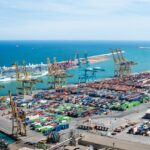The U.S. truckload market is stabilizing with spot rates rising, capacity tightening, and tender rejections increasing—signaling a potential shift toward equilibrium in mid-2025. Here’s what it means for your logistics strategy.
📉 Market Status: Capacity Under Control, Rates Finally Rising
In the first quarter of 2025, the U.S. truckload market saw a noteworthy turnaround:
-
Spot rates (excluding fuel) climbed 9.1% YoY, recovering from an 11.6% increase in Q4 2024.
-
Contract rates increased 1.4% YoY, marking the first sustained growth since the end of 2022 freightwaves.com.
This steady rise in both spot and contractual rates indicates that the long-standing freight recession may be ending.
⚖️ Closer to Balance: Why Capacity Is Tightening
Mid-2025 data reveals that the exodus of small carriers—driven by inflation, high interest rates, and rising operational costs—has finally brought supply and demand closer to balance .
As RXO stated:
“We’re as close to equilibrium, in terms of carrier supply and shipper demand, as we’ve been in over two years.”
Still, capacity remains fragile compared to last year, suggesting that any significant surge or disruption could easily shake the market back out of balance .
📊 The Tender Rejection Signal
One key sign of market tension is the Outbound Tender Rejection Index—the percentage of loads carriers are refusing to accept. In June 2025, this measure climbed above 6.6%, indicating growing scarcity in accepted capacity. freightwaves.com.
Enterprise shippers typically expect 90% tender acceptance, so rising rejections signal an unbalanced market that could drive spot rate inflation quickly if sustained.
🌎 Regional Imbalances Emerging
A markdown of trends:
-
Southeast U.S.: Tender rejections topped 10%—a three-year high—despite volume dropping 6% YoY
-
West Coast: Rejection rates remained below the national average, largely due to strong intermodal (rail + truck) flows that offloaded many long-haul shipments. Container rail volumes out of Los Angles even increased Inland Hubs: Cities like Atlanta (8.9%), Chicago (7.1%), and Dallas (6.9%) also recorded above-average rejection levels, underscoring persistent capacity constraints outside of coastal routes .
💸 What This Means for Stakeholders
-
Shippers should expect higher costs, especially in hot regions like the Southeast and major inland freight hubs.
-
Carriers are in a stronger position as capacity tightens—spot market leverage is returning.
-
Brokers and 3PLs need to act swiftly, securing capacity with flexible contracts or spot tier strategies to meet shipper needs.
-
Intermodal players continue to benefit from rail-truck modal shifts, especially along the West Coast.
🔍 What to Watch Next
-
Will tender rejection rates stay elevated through peak shipping season?
-
Could rate inflation accelerate if new capacity doesn’t re-enter the market?
-
How will macro factors—like tariff changes or economic slowdowns—affect freight demand?
✅ Final Take
After two years of oversupply and stagnation, the truckload market in mid-2025 is showing clear signs of recovery. Spot rates are rising, contract rates are turning positive, and capacity pressures are building—evidence that supply and demand are moving toward equilibrium.
The next few months will reveal whether this balance holds through peak season or if further shifts are needed to sustain the momentum.





